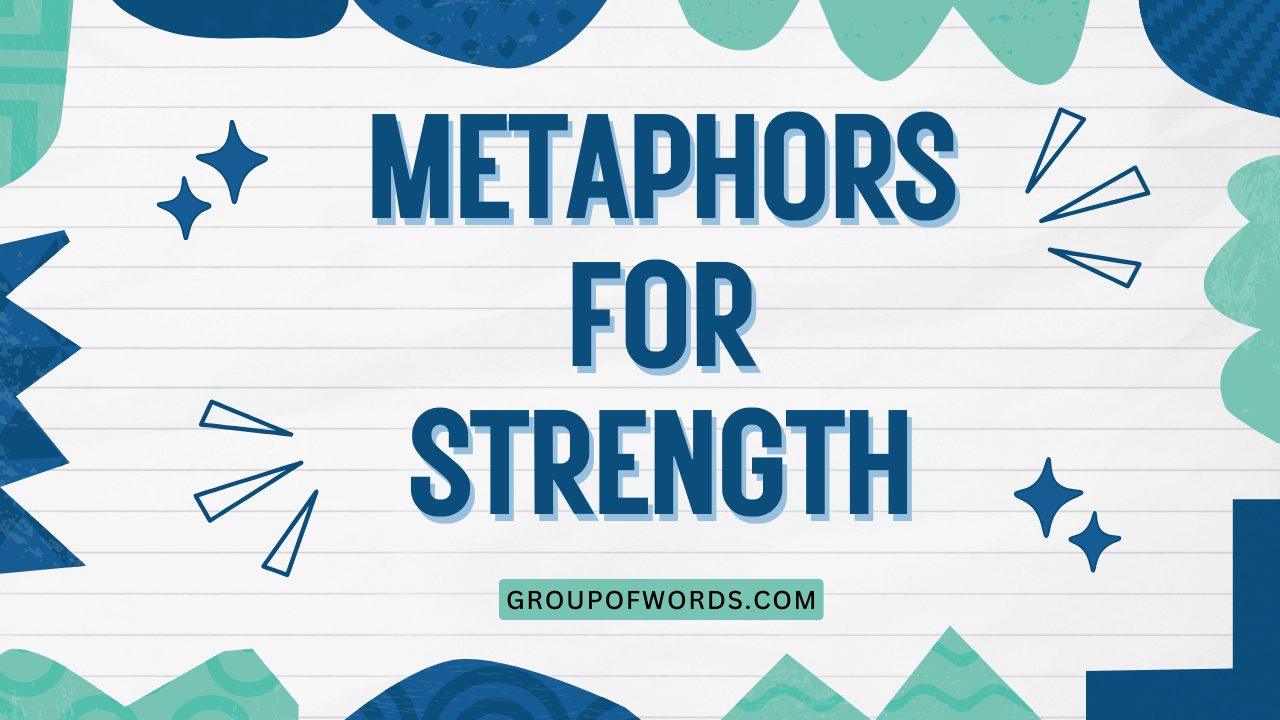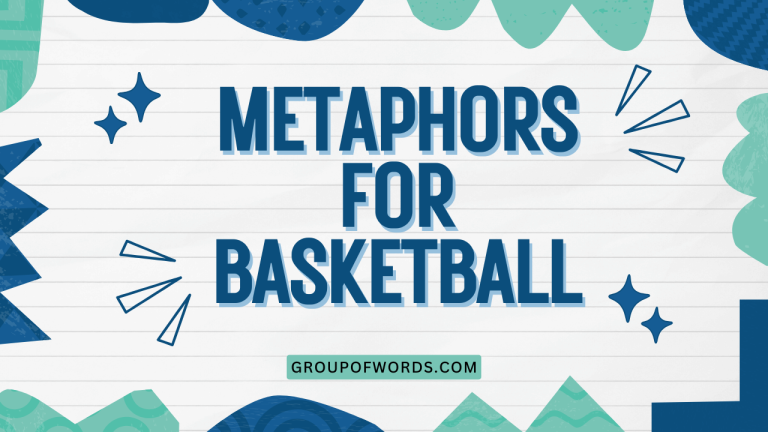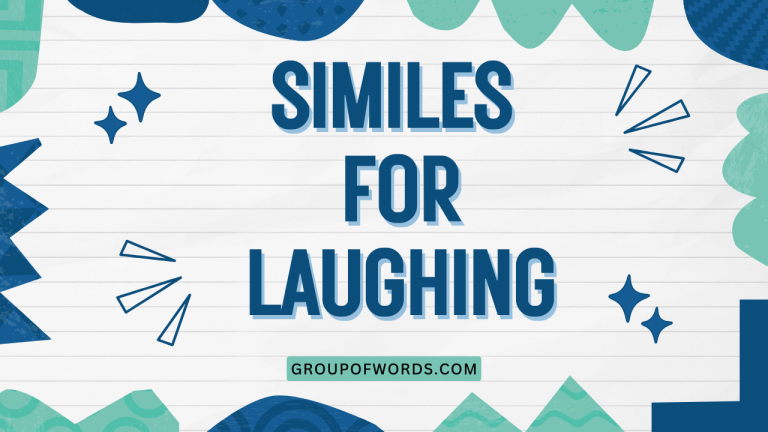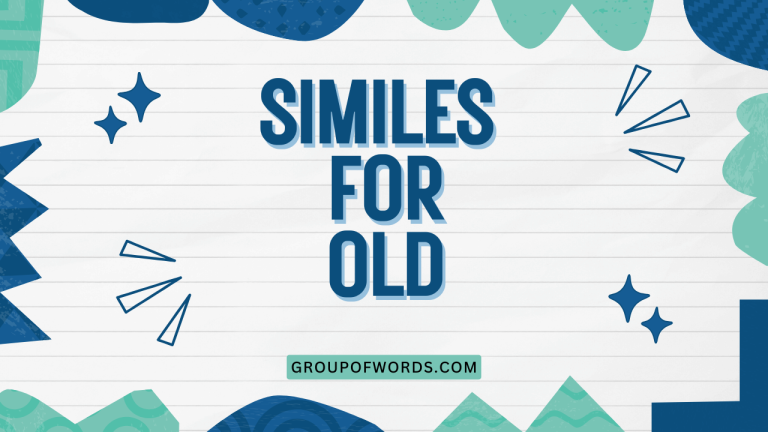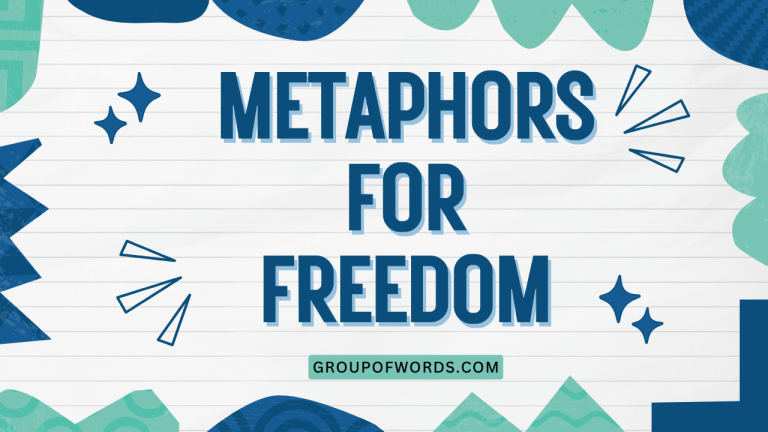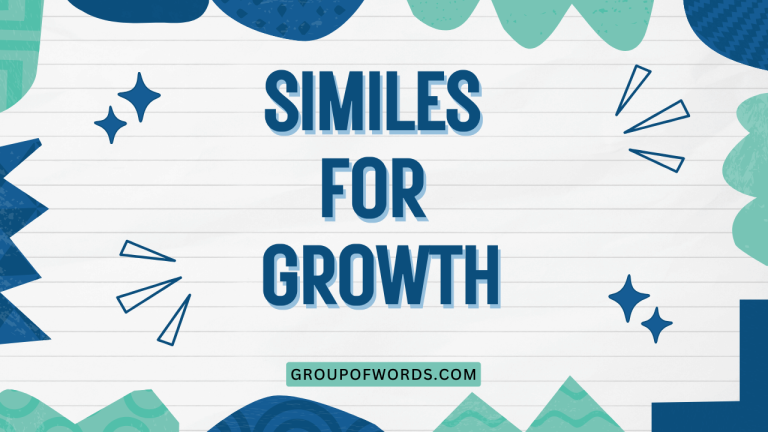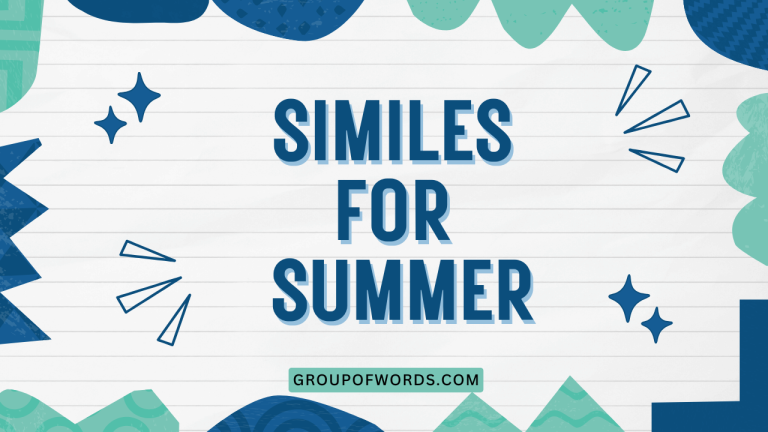Metaphors for Strength: A Comprehensive Guide
Understanding metaphors is crucial for mastering English, as they add depth and color to language. Metaphors for strength are particularly important because they help us express resilience, power, and fortitude in vivid and memorable ways.
This article will explore various types of strength metaphors, providing numerous examples and practical exercises. Whether you’re an English language learner or a native speaker, this guide will enhance your ability to use and understand these powerful figures of speech.
Table of Contents
- Introduction
- Definition of Metaphor for Strength
- Structural Breakdown
- Types and Categories of Strength Metaphors
- Examples of Strength Metaphors
- Usage Rules for Strength Metaphors
- Common Mistakes with Strength Metaphors
- Practice Exercises
- Advanced Topics
- FAQ
- Conclusion
Definition of Metaphor for Strength
A metaphor for strength is a figure of speech that compares a person, object, or idea to something else that embodies power, resilience, or fortitude, without using “like” or “as.” Unlike similes, which make explicit comparisons, metaphors imply a similarity by stating that one thing *is* another. These metaphors are essential in conveying the extent and nature of strength in a more evocative and impactful manner. They transform abstract qualities into tangible, relatable images.
The function of strength metaphors is to enhance understanding and emotional connection. By associating strength with concrete images, we can better grasp the magnitude and impact of someone’s power or resilience.
The contexts in which these metaphors are used are varied, ranging from literature and poetry to everyday conversations and motivational speeches. They are particularly useful in situations where direct descriptions fall short of capturing the true essence of strength.
Structural Breakdown
The structure of a strength metaphor typically involves two key elements: the tenor and the vehicle. The tenor is the subject being described (e.g., a person’s resilience), and the vehicle is the object or concept used to represent that subject (e.g., a rock). The connection between the tenor and the vehicle is based on shared characteristics or associations related to strength. For instance, a person described as having a “heart of steel” uses “heart” as the tenor (the emotional core of the person) and “steel” as the vehicle (representing unyielding strength and resilience). The implied similarity lies in the hardness, durability, and resistance to damage that both a steel and a resilient heart possess.
The effectiveness of a strength metaphor depends on how well the vehicle conveys the intended meaning. A well-chosen vehicle will resonate with the audience, creating a vivid image and enhancing their understanding of the tenor.
Consider the metaphor “He is a fortress.” Here, “he” is the tenor, and “fortress” is the vehicle. The metaphor suggests that the person is strong, secure, and difficult to penetrate, much like a fortified structure.
The structural pattern is simple: subject (tenor) + linking verb (is) + metaphorical representation (vehicle).
Types and Categories of Strength Metaphors
Strength metaphors can be categorized based on the source of the imagery they draw upon. These categories help to understand the different ways in which strength can be conceptualized and expressed.
Animal Metaphors
Animal metaphors use the characteristics of animals to represent strength. Certain animals are universally associated with specific types of strength, such as physical power (lion), endurance (ox), or resilience (turtle).
These metaphors can be particularly evocative, tapping into our innate understanding of the animal kingdom.
Nature Metaphors
Nature metaphors draw on elements of the natural world to symbolize strength. Mountains, rivers, and storms can all represent different facets of strength, such as unwavering stability (mountain), relentless force (river), or overwhelming power (storm).
These metaphors often convey a sense of grandeur and scale.
Material/Object Metaphors
Material metaphors use materials like steel, iron, or diamond to represent strength. These metaphors often highlight the durability, hardness, and resistance to damage.
Objects such as fortresses, shields, or anchors can also be used to symbolize protection, stability, and steadfastness.
Physical Attribute Metaphors
These metaphors relate to physical attributes that symbolize strength, such as having strong roots (representing stability) or a solid foundation (representing resilience). They often connect physical characteristics to inner strength or character.
Abstract Concept Metaphors
Abstract metaphors use abstract concepts like “backbone” or “moral compass” to represent strength of character or integrity. These metaphors often relate to inner strength and the ability to stand up for one’s beliefs.
Examples of Strength Metaphors
The following tables provide extensive examples of strength metaphors, categorized by type. Each example illustrates how different vehicles can be used to convey the concept of strength in various contexts.
Animal Metaphor Examples
The table below presents a range of animal metaphors used to describe strength. Each example highlights how different animals’ characteristics can be associated with human qualities such as resilience, power, and courage.
| Metaphor | Explanation |
|---|---|
| He is a lion in battle. | Represents courage and ferocity. |
| She is as strong as an ox. | Implies great physical strength and endurance. |
| He has the tenacity of a bulldog. | Suggests unwavering determination and persistence. |
| She is a rock badger, unyielding to pressure. | Symbolizes resilience and the ability to withstand hardship. |
| He fights with the heart of a tiger. | Indicates fierce determination and predatory strength. |
| She is like a bear protecting her cubs. | Represents protective strength and fierce love. |
| He is as stubborn as a mule. | Implies unwavering determination, though sometimes negatively. |
| She is a wolf in sheep’s clothing. | Suggests hidden strength and potential danger. |
| He moves with the grace of a panther. | Implies a combination of strength and agility. |
| She is a soaring eagle, always rising above challenges. | Symbolizes freedom and the ability to overcome obstacles. |
| He is as brave as a lion. | Represents fearlessness and courage in the face of adversity. |
| She has the strength of a rhino. | Implies immense physical power and resilience. |
| He is like a honey badger; he doesn’t care. | Illustrates fearlessness and unwillingness to back down. |
| She is a mother hen, always protecting her children. | Represents nurturing strength and care. |
| He is as cunning as a fox. | Suggests strategic strength and intelligence. |
| She is a silent predator, like a snake. | Implies stealthy strength and hidden power. |
| He is a tireless worker, like an ant. | Represents diligence and collective strength. |
| She is as graceful under pressure as a swan. | Implies elegance and composure in difficult situations. |
| He is a loyal companion, like a dog. | Represents unwavering support and devotion. |
| She is a resilient creature, like a cockroach. | Symbolizes the ability to survive and thrive in harsh conditions. |
| He is a pack animal, like a wolf. | Indicates strength in unity and teamwork. |
| She is as gentle and strong as an elephant. | Implies immense power combined with kindness. |
| He is a bird of prey, soaring high above the rest. | Represents dominance and superior strength. |
| She is as watchful as an owl. | Implies wisdom and observant strength. |
| He is a worker bee, contributing to the hive. | Represents diligence and collaborative strength. |
Nature Metaphor Examples
This table showcases metaphors that use elements of nature to symbolize strength. These examples illustrate how natural phenomena can represent resilience, stability, and power.
| Metaphor | Explanation |
|---|---|
| He is a mountain, unyielding to the storm. | Represents steadfastness and resilience. |
| She is a force of nature. | Implies overwhelming power and influence. |
| He is a deep river, always flowing forward. | Suggests persistence and continuous progress. |
| She is a sturdy oak, weathering every season. | Symbolizes resilience and longevity. |
| He is a raging fire, burning with passion. | Indicates intense energy and determination. |
| She is a gentle breeze, but can become a hurricane if provoked. | Represents hidden strength and potential for destruction. |
| He is a solid rock, providing stability. | Implies reliability and unwavering support. |
| She is a growing vine, always reaching for the sun. | Suggests ambition and continuous growth. |
| He is a towering tree, providing shelter and strength. | Represents protection and stability. |
| She is a blossoming flower, resilient even in harsh conditions. | Symbolizes beauty and strength in adversity. |
| He is a roaring waterfall, a symbol of untamed power. | Indicates raw energy and unstoppable force. |
| She is a quiet forest, full of hidden strength. | Represents inner resilience and untapped potential. |
| He is a shifting desert, unpredictable and dangerous. | Suggests a volatile strength that can be formidable. |
| She is a calm sea, but can rage with fury. | Implies hidden strength and emotional depth. |
| He is a mighty volcano, waiting to erupt. | Represents suppressed strength that can be unleashed. |
| She is a gentle rain, nourishing and life-giving. | Symbolizes nurturing strength and support. |
| He is a powerful earthquake, shaking the foundations. | Indicates disruptive strength and transformative power. |
| She is a bright star, shining through the darkness. | Represents hope and unwavering strength. |
| He is a vast ocean, full of mystery and power. | Implies immense depth and untapped potential. |
| She is a dense jungle, resilient and teeming with life. | Symbolizes endurance and the ability to thrive in adversity. |
| He is a steady wind, guiding and persistent. | Represents consistent strength and direction. |
| She is a fertile ground, nurturing and supportive. | Implies supportive strength and the ability to foster growth. |
| He is a frozen tundra, unyielding and stark. | Represents cold, unbending strength. |
| She is a bright sun, radiating warmth and energy. | Symbolizes vitality and positive strength. |
| He is a tranquil lake, reflecting inner peace and strength. | Represents inner calm and resilience. |
Material/Object Metaphor Examples
This table illustrates how different materials and objects can be used metaphorically to represent strength. These examples highlight qualities such as durability, protection, and steadfastness.
| Metaphor | Explanation |
|---|---|
| He has a heart of steel. | Represents unyielding resilience and emotional fortitude. |
| She is a fortress, protecting her loved ones. | Implies protection and unwavering defense. |
| He is an anchor, providing stability in chaos. | Suggests reliability and steadfast support. |
| She is a shield, deflecting negativity. | Symbolizes protection and resilience against harm. |
| He is a diamond, unbreakable under pressure. | Indicates exceptional resilience and durability. |
| She is a solid wall, impervious to attack. | Represents impenetrable strength and defense. |
| He is a sturdy bridge, connecting people. | Implies support and the ability to overcome obstacles. |
| She is a lighthouse, guiding others through darkness. | Suggests guidance and unwavering support. |
| He is a strong chain, binding us together. | Represents unity and collective strength. |
| She is a sharp sword, cutting through obstacles. | Symbolizes decisive action and the ability to overcome challenges. |
| He is a solid foundation, providing a base for growth. | Indicates stability and support for development. |
| She is a resilient spring, bouncing back from setbacks. | Represents the ability to recover quickly from adversity. |
| He is a sturdy rope, able to withstand great strain. | Suggests resilience and the ability to endure hardship. |
| She is a well-oiled machine, functioning flawlessly. | Implies efficiency and unwavering performance. |
| He is a mighty hammer, shaping the world. | Represents transformative power and influence. |
| She is a flexible rod, bending but not breaking. | Symbolizes adaptability and resilience in the face of challenges. |
| He is a reliable clock, always consistent. | Indicates dependability and unwavering performance. |
| She is a strong magnet, attracting success. | Suggests the ability to draw in positive outcomes. |
| He is a sturdy wheel, keeping things in motion. | Represents continuous progress and reliability. |
| She is a powerful engine, driving progress forward. | Symbolizes momentum and the ability to achieve goals. |
| He is a resilient net, catching opportunities. | Indicates the ability to seize and retain positive outcomes. |
| She is a brilliant mirror, reflecting inner strength. | Suggests self-awareness and confidence. |
| He is a protective helmet, guarding against harm. | Represents safety and security. |
| She is a supportive pillar, holding everything together. | Symbolizes stability and unwavering support. |
| He is a reliable compass, guiding the way. | Represents direction and moral strength. |
Abstract Concept Metaphor Examples
The following table presents metaphors using abstract concepts to represent different facets of strength. These examples illustrate how abstract ideas can symbolize courage, resilience, and moral fortitude.
| Metaphor | Explanation |
|---|---|
| He has a strong backbone. | Represents moral strength and the ability to stand up for principles. |
| She is a moral compass. | Implies integrity and unwavering ethical guidance. |
| He has nerves of steel. | Suggests unwavering composure and courage. |
| She is the heart of the team. | Symbolizes emotional strength and unity. |
| He has an iron will. | Indicates unwavering determination and resolve. |
| She is a pillar of the community. | Represents stability and unwavering support. |
| He has a resilient spirit. | Implies the ability to bounce back from adversity. |
| She is the embodiment of courage. | Suggests exceptional bravery and fearlessness. |
| He has an unyielding resolve. | Represents unwavering determination. |
| She is a beacon of hope. | Symbolizes guidance and inspiration in dark times. |
| He has a formidable presence. | Indicates a strong and impactful character. |
| She is the voice of reason. | Represents logical strength and clarity. |
| He has a strong sense of justice. | Suggests moral strength and fairness. |
| She is a reservoir of strength. | Implies an abundance of inner resilience. |
| He possesses unwavering faith. | Represents spiritual strength and conviction. |
| She is a fountain of inspiration. | Suggests the ability to motivate and empower others. |
| He has a rock-solid reputation. | Indicates unwavering integrity and reliability. |
| She is the embodiment of resilience. | Symbolizes the ability to overcome challenges. |
| He has an unbreakable spirit. | Represents unwavering determination and resilience. |
| She is a symbol of hope. | Suggests guidance and inspiration in difficult times. |
Usage Rules for Strength Metaphors
Using strength metaphors effectively requires understanding certain guidelines. First, ensure that the metaphor is appropriate for the context. A metaphor that works well in a literary context might be out of place in a formal business presentation. Second, maintain consistency within your writing. Avoid mixing metaphors that create conflicting images. Third, be original where possible. While common metaphors can be effective, fresh and creative metaphors can add greater impact.
Exceptions to these rules often occur in creative writing, where unconventional metaphors can be used for artistic effect. However, in most formal contexts, it’s best to adhere to the guidelines. For example, mixing metaphors like “He is a lion with a heart of stone climbing the corporate ladder” can create a confusing and disjointed image. A better approach would be to choose a single, consistent metaphor that effectively conveys the intended meaning.
Common Mistakes with Strength Metaphors
One common mistake is using clichéd metaphors that have lost their impact through overuse. For instance, saying someone is “as strong as an ox” is grammatically a simile, but is often used as a metaphor in common parlance. While understandable, it lacks originality and can make your writing seem uninspired. Another mistake is creating mixed metaphors, which combine incongruous images. For example, “He is a rock in the storm, but he also juggles many balls in the air” creates a confusing picture because being a rock implies stability, while juggling suggests dynamism. A better sentence would be: “He is a rock in the storm, providing stability to those around him.”
Another frequent error is using metaphors that are too abstract or obscure. If the audience cannot easily understand the connection between the tenor and the vehicle, the metaphor will fail to communicate the intended meaning. For example, saying “He is a fractal of fortitude” might be confusing unless the audience understands the complex nature of fractals. Instead, use a more accessible metaphor, such as “He is a tower of strength.”
Here are some examples of common mistakes and their corrections:
| Incorrect | Correct |
|---|---|
| He is as strong as an ox. | He is an unyielding ox in the face of hardship. |
| She is a rock in the storm, navigating the sea of life. | She is a rock in the storm, providing stability to those around her. |
| He is a fractal of fortitude. | He is a tower of strength. |
| She is a phoenix, climbing the corporate ladder. | She is a phoenix, rising from the ashes of her previous failures. |
Practice Exercises
Test your understanding of strength metaphors with the following exercises. Identify the type of metaphor used in each sentence and explain its meaning.
Then create your own sentences using strength metaphors.
Exercise 1: Identifying Metaphor Types
Identify the type of strength metaphor used in each sentence (Animal, Nature, Material, Abstract, Physical Attribute).
| Question | Answer |
|---|---|
| 1. He has an iron will. | Abstract |
| 2. She is a fortress of solitude. | Material |
| 3. He is a mountain, unyielding to pressure. | Nature |
| 4. She is as brave as a lion. | Animal |
| 5. He has strong roots in the community. | Physical Attribute |
| 6. She is the backbone of the organization. | Abstract |
| 7. He is a deep river, always flowing forward. | Nature |
| 8. She is as tenacious as a bulldog. | Animal |
| 9. He is a shield against negativity. | Material |
| 10. She has a solid foundation of values. | Physical Attribute |
Exercise 2: Creating Strength Metaphors
Complete the following sentences by adding an appropriate strength metaphor.
| Question | Answer |
|---|---|
| 1. Despite the setbacks, he remained __________. | a mountain, unyielding |
| 2. She faced the challenge with __________. | the heart of a lion |
| 3. His determination was __________. | an iron fist |
| 4. The team relied on her as __________. | a moral compass |
| 5. In times of crisis, he was __________. | a sturdy anchor |
| 6. She protected her family like __________. | a protective fortress |
| 7. His spirit was __________. | an unbreakable diamond |
| 8. The community saw her as __________. | a pillar of strength |
| 9. He approached the task with __________. | the relentless force of a river |
| 10. Her resilience was __________. | a beacon of hope |
Exercise 3: Correcting Mixed Metaphors
Identify and correct the mixed metaphors in the following sentences.
| Question | Answer |
|---|---|
| 1. He is a rock in the storm, but he also juggles many balls in the air. | He is a rock in the storm, providing stability to those around him. |
| 2. She is a phoenix, climbing the corporate ladder. | She is a phoenix, rising from the ashes of her previous failures. |
| 3. His words were a shield, paving the way to success. | His words were a shield, protecting his reputation. OR His words paved the way to success. |
| 4. She is a lighthouse, but also a flexible rod. | She is a lighthouse, guiding others through darkness. OR She is a flexible rod, bending but not breaking. |
| 5. He has a heart of steel, but also wears his emotions on his sleeve. | He has a heart of steel, unyielding to emotional pressure. OR He wears his emotions on his sleeve, showing vulnerability. |
| 6. She is a diamond, navigating the rough seas of life. | She is a diamond, unbreakable under pressure. OR She is a skilled sailor, navigating the rough seas of life. |
| 7. His determination was a fire, planting seeds of success. | His determination was a fire, burning with passion. OR His actions planted the seeds of success. |
| 8. She is the backbone of the team, spreading her wings to fly. | She is the backbone of the team, providing unwavering support. OR She is spreading her wings to fly, embarking on a new journey. |
| 9. He is a sturdy bridge, but also a sharp sword. | He is a sturdy bridge, connecting people. OR He is a sharp sword, cutting through obstacles. |
| 10. She is a fountain of inspiration, but also building a fortress. | She is a fountain of inspiration, motivating others. OR She is building a fortress, protecting her family. |
Advanced Topics
For advanced learners, exploring the cultural and historical contexts of strength metaphors can provide deeper insights. Different cultures often associate different symbols with strength.
For example, in some cultures, the dragon represents strength and power, while in others, it may symbolize chaos and destruction. Understanding these nuances can enhance your ability to use strength metaphors effectively in cross-cultural communication.
Additionally, consider the use of extended metaphors, where a single metaphor is developed over several sentences or paragraphs. This technique can create a more powerful and immersive image, but it requires careful planning and execution. For instance, an extended metaphor about a person being a “ship” could explore their journey, the storms they face, and their ability to navigate through challenges.
FAQ
Here are some frequently asked questions about strength metaphors:
- What is the difference between a metaphor and a simile?
A metaphor implies a comparison by stating that one thing *is* another, while a simile makes an explicit comparison using “like” or “as.” For example, “He is a lion” is a metaphor, while “He is as brave as a lion” is a simile. - Why are metaphors important in writing?
Metaphors add depth, color, and emotional resonance to writing. They can make abstract concepts more concrete and understandable, and they can create vivid images in the reader’s mind. - How can I avoid using clichéd metaphors?
Strive for originality by brainstorming fresh and creative comparisons. Consider the specific qualities you want to convey and look for unique ways to represent them. - What should I do if I accidentally create a mixed metaphor?
Identify the conflicting images in the metaphor and revise the sentence to create a more consistent and coherent picture. Choose a single, dominant metaphor and develop it effectively. - Can metaphors be used in formal writing?
Yes, but use them judiciously. Ensure that the metaphors are appropriate for the context and that they enhance, rather than detract from, the clarity and professionalism of your writing. - How do I choose the right metaphor for strength?
Consider the specific type of strength you want to convey (e.g., physical, emotional, moral) and choose a vehicle that effectively represents that quality. Think about your audience and select a metaphor that will resonate with them. - Are there any cultures where certain strength metaphors might be offensive?
Yes, cultural understanding is crucial. Some animals or natural elements might have negative connotations in certain cultures. Research the cultural context to avoid unintended offense. - How can I practice using strength metaphors effectively?
Read widely and pay attention to how other writers use metaphors. Experiment with different metaphors in your own writing and seek feedback from others. Practice identifying and correcting mixed metaphors.
Conclusion
Mastering the use of strength metaphors can significantly enhance your ability to communicate effectively and expressively. By understanding the different types of strength metaphors, following usage rules, and avoiding common mistakes, you can add depth, color, and emotional impact to your writing and speech.
Remember to practice regularly and seek feedback to refine your skills. Embrace the power of metaphors to convey the true essence of strength in all its varied forms.
Continue to explore and experiment with different metaphors to expand your linguistic toolkit. The ability to use metaphors effectively is a valuable asset in both personal and professional communication.
With practice and attention to detail, you can become a master of metaphorical language, enriching your writing and captivating your audience.
